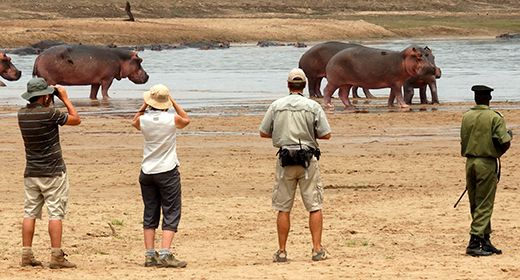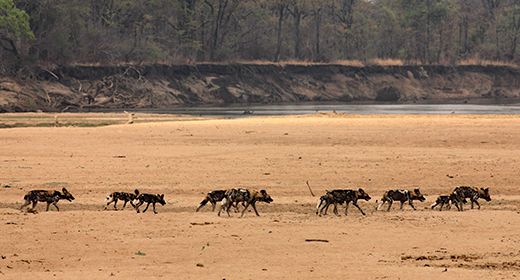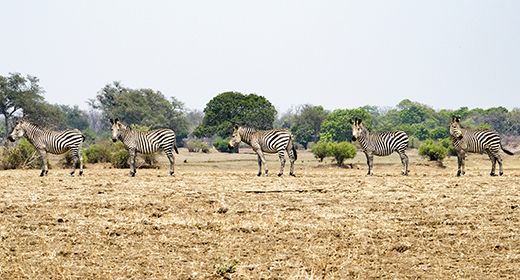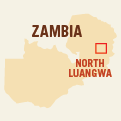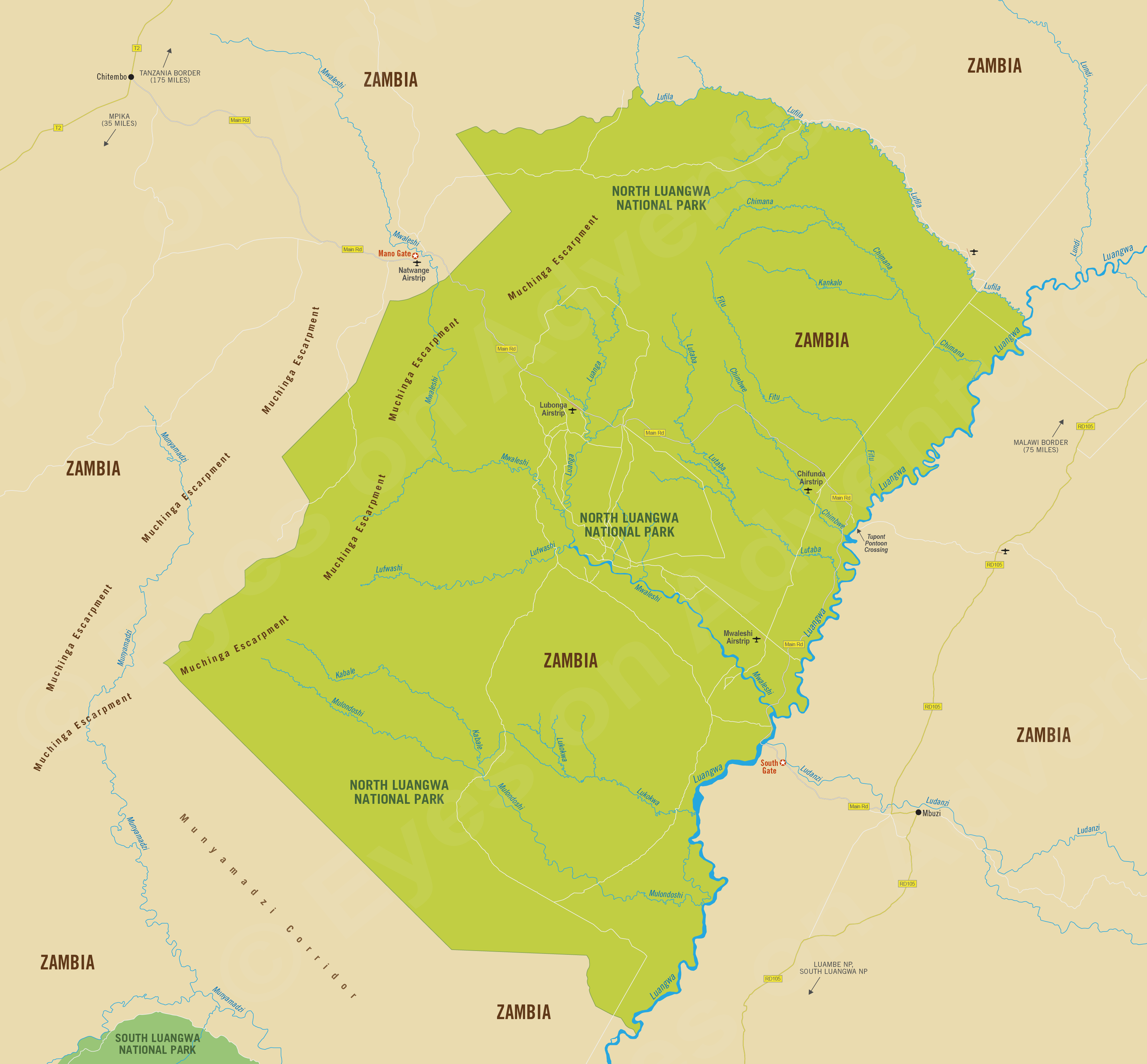North Luangwa
(incl. North Luangwa National Park)
Region Links: Kafue, Livingstone, Lower Zambezi (Zambia), North Luangwa, South Luangwa
Highlights
- More wild and remote than South Luangwa
- Primarily a walking safaris destination
- Only a few safari camps in a vast wilderness
- Diverse and abundant wildlife, including the Big Five
EOA Recommends: Buffalo Camp (Seasonal), Luangwa North Camp, Mwaleshi Camp (Seasonal)
North Luangwa National Park is wild and remote, mostly undeveloped, and full of wildlife. The reserve is set in the beautiful Luangwa River Valley and authentic walking safaris are the main attraction.
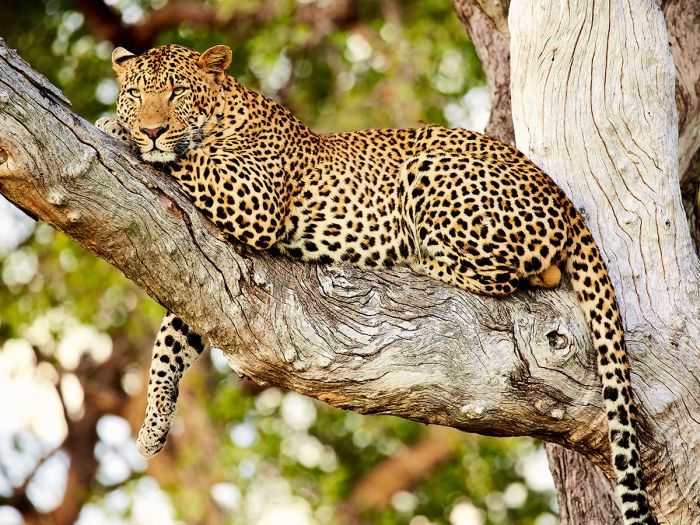
The Luangwa Valley is a great place to see leopards
Situated just north of the larger and far more developed South Luangwa National Park, North Luangwa is bounded by the Luangwa River on its east and by the Muchinga Escarpment on the west.
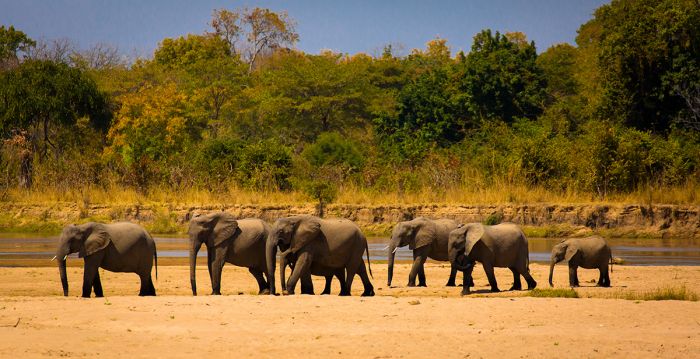
Elephants on the banks of the Luangwa River
Wildlife in North Luangwa is mostly the same as in South Luangwa, with the notable exception of giraffe, which are absent from the north park. There are healthy populations of lion, leopard, buffalo, elephant, spotted hyena, African wild dogs, zebra, puku, impala and more. North Luangwa also boasts Zambia's only existing population of black rhino. Bird life is diverse.
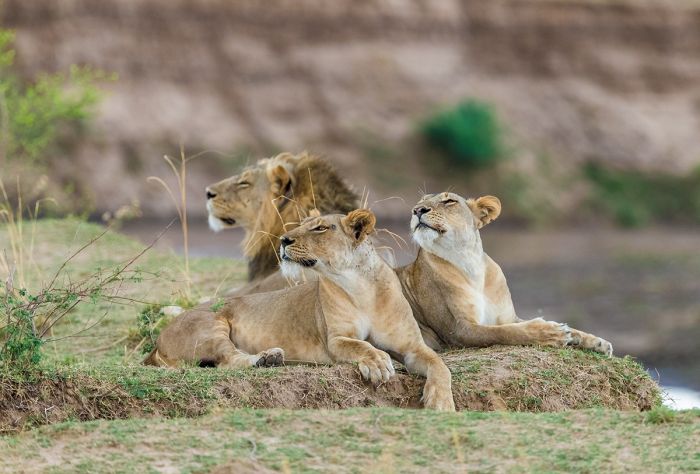
Lions are the most common predator in the Luangwa Valley
The Luangwa Valley is subject to distinct rainy and dry seasons. During the rainy months (November thru April), many of the park's roads may become inaccessible and safari camps are closed.
The 'North Park' is a place that is truly wild and remote; a place for those who want to really get away from the well-traveled reserves. The few safari camps in North Luangwa offer a true wilderness experience, with walking the main activity. Visitors to the park are likely to feel as if they have the entire place to themselves!
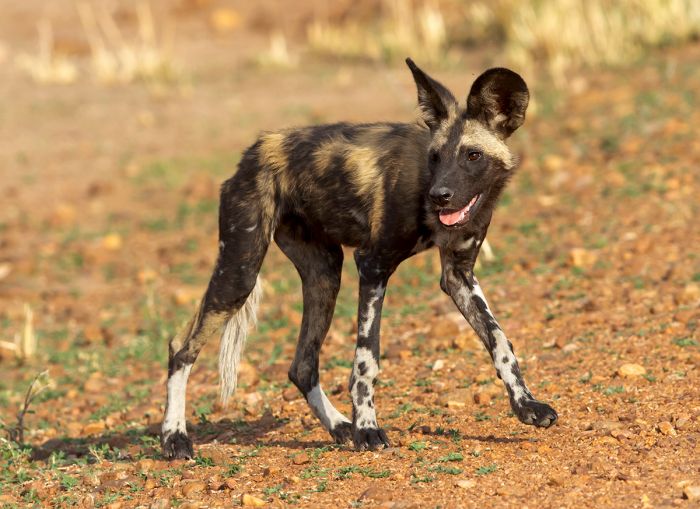
The endangered African wild dog is often seen in Luangwa
Read More...
Geography, History, Poaching, The Owens', Walking Safaris, Wildlife
History
Archeological evidence suggests that hominids have lived in the Luangwa Valley for about 2 million years or longer. Our early human ancestors existed in the valley throughout the Stone Age and pastoralists brought their herds and agriculture to the valley sometime around AD 400.
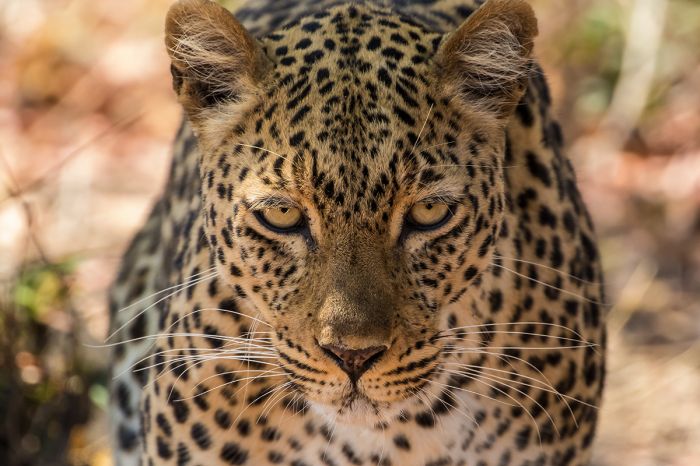
Leopards are seen frequently in North Luangwa
In more modern times, the Portuguese began inhabiting the region in support of the profitable ivory and slave trade in the early 1700s. The Zambezi River was the main artery connecting the region to the Indian Ocean and Portuguese trading settlements migrated north from the confluence of the Luangwa and Zambezi rivers up into the rich Luangwa Valley.
Throughout the 1800s, the Luangwa Valley became renowned for having rich wildlife, especially big tusker elephants, which brought many European hunters to the region in search of fortune. The famous explorer David Livingstone arrived in Luangwa in 1866, proclaiming it to be one of the richest places he had yet seen.
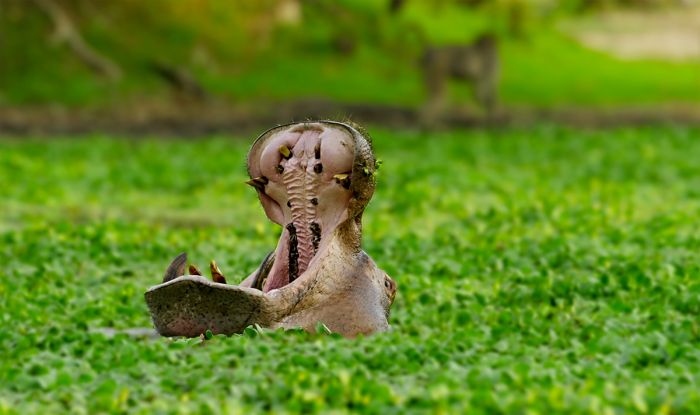
The rainy season is a happy time for the hippos in the Luangwa River
In 1888, Cecil Rhodes obtained mineral rights from local chiefs and Britain proclaimed all of what is today Zambia and Zimbabwe as a British colony, which they called Rhodesia. Subsequently, the first protected reserve was created in the Luangwa Valley, which was named the Luangwa Game Park. Upkeep and enforcement was lacking and the reserve failed.
Years later in 1938, three game reserves were declared in the Luangwa: South Luangwa's Game Reserve, North Luangwa Game Reserve, and Lukusuzi Game Reserve. Unfortunately, in the years following the formation of these parks, most of the focus and funding was devoted to South Luangwa, so North Luangwa suffered from rampant poaching of its rhinos and elephants.
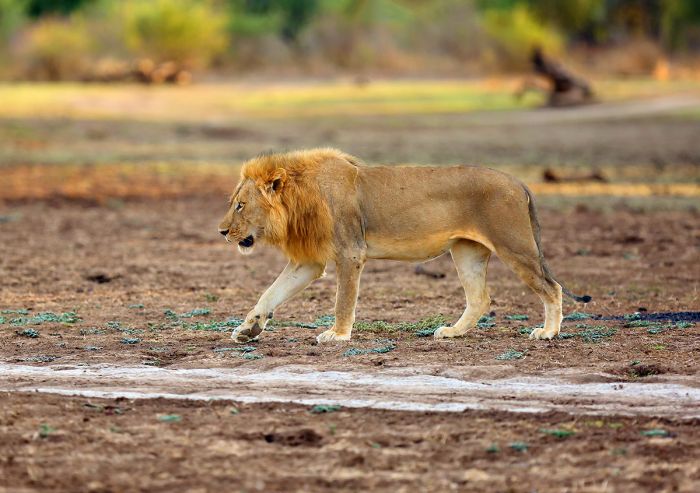
A lovely male lion in Luangwa
Poaching
Heavy demand for rhino horn and elephant ivory in Asia during the 1970s and early 1980s created a disastrous poaching situation in the Luangwa Valley. While other countries in Southern Africa instituted "shoot-to-kill" policies to combat poaching, Zambia had no such policy and so its parks, especially those in Luangwa, were targeted by organized commercial poaching organizations.
Armed with automatic weapons, the poachers killed huge numbers of elephants and rhinos in Luangwa. The elephant population in the Luangwa Valley was reduced by poachers from 85 000 in the late 1960s, to just 5 000 by the late 1980s.
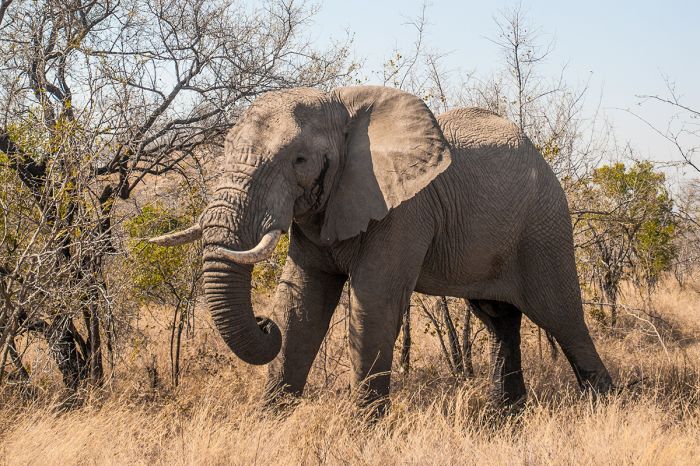
Luangwa's elephants are rebounding after poaching in the 1980s
Sadly, all of Luangwa's rhinos were killed and only a small number of black rhinos (reintroduced and heavily guarded) exist today in North Luangwa (South Luangwa has no rhinos). Luangwa's elephants have rebounded somewhat and today number around 18 000, with poaching under control and uncommon.
The Owens'
In 1986, Mark and Delia Owens, American conservationists who had gained considerable recognition for their years of research in Botswana's Central Kalahari during the mid-1970s, visited North Luangwa in hopes of finding a new wilderness for continuing their wildlife research. They obtained permission and returned to North Luangwa in 1987, where they created their base camp.
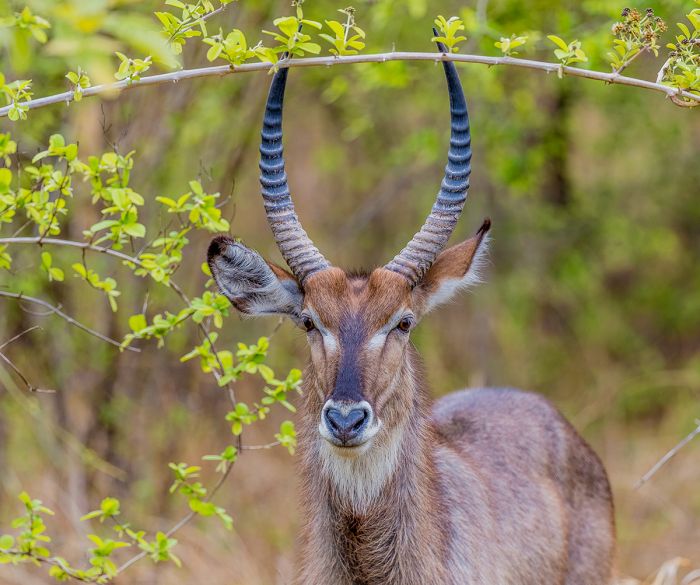
Common waterbuck in the Luangwa Valley
The Owens' best-selling book The Cry of the Kalahari (published 1984), which chronicles their experiences in Botswana, brought conservation and poaching problems to a global audience, as well as gaining them considerable financial backing, most notably from the Frankfurt Zoological Society.
Roughly 1 000 elephants were still being killed every year in North Luangwa, and the Owens' research quickly morphed into a personal battle they waged against the illegal poaching taking place in the park. The couple lived and worked in North Luangwa until 1996, when an 'incident' occurred in which a poacher was allegedly killed by Mark Owens.
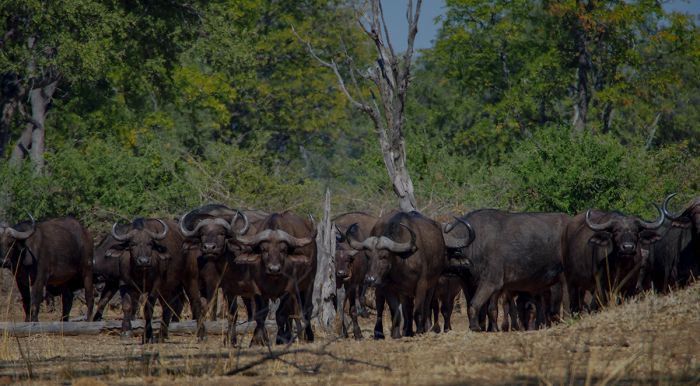
Big herds of buffalo are present in the Luangwa
The Owens' departed Zambia for good immediately afterward. Their second best-selling book, The Eye of the Elephant (published 1993), follows their experiences living in North Luangwa and their struggles to combat poaching in the park.
Regardless of what anyone may think about their controversial methods, the Owens' work and their popular books brought high-profile wildlife conservation to the world, increasing attention on Africa's problems with poaching, with lasting effects. In North Luangwa, their enduring legacy is that they introduced the Frankfurt Zoological Society (FZS) to the park.
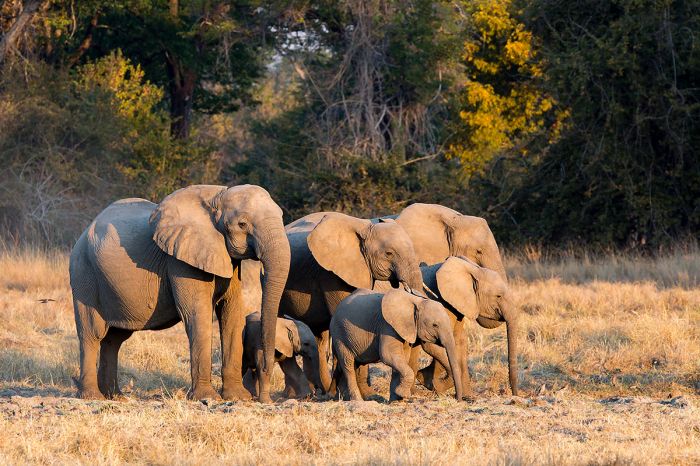
Elephants in North Luangwa
The FZS' continued long-term financial support has been a huge benefit to North Luangwa and through the support of FZS and many other donors, the North Luangwa Conservation Programme (NLCP) was created.
The NLCP is a partnership between the FZS and Zambia's Department of National Parks and Wildlife. NLCP focuses its efforts on management and law enforcement, as well as working with local communities by engaging and employing them in conservation and eco-tourism.
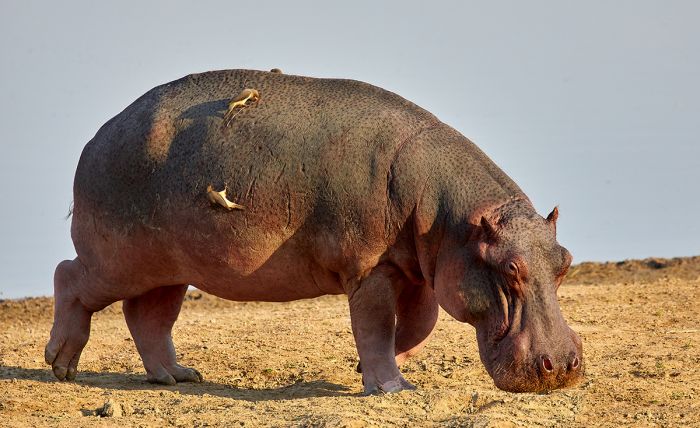
The Luangwa River is home to large numbers of hippo
Geography
North Luangwa National Park covers 1 819 square miles (4 712 sq kms) in the lush Luangwa Valley of Eastern Zambia. North Luangwa lies only 15 miles (24 kms) north of the much larger South Luangwa National Park. Like the 'South Park', the Luangwa River forms North Luangwa's eastern border, while the Muchinga Escarpment runs through the western portion of the park.
The Muchinga Escarpment rises to 2 700-3 950 feet (820-1 200 m) along the western side of the park and the terrain slopes down towards the Luangwa River at around 1 970 feet (600 m) on the valley floor. Unlike the South Park, where the escarpment wall forms the western boundary but lies mostly outside the park, in North Luangwa the escarpment itself lies mostly within the park, so all of the Luangwa River's western catchment is protected within the park.
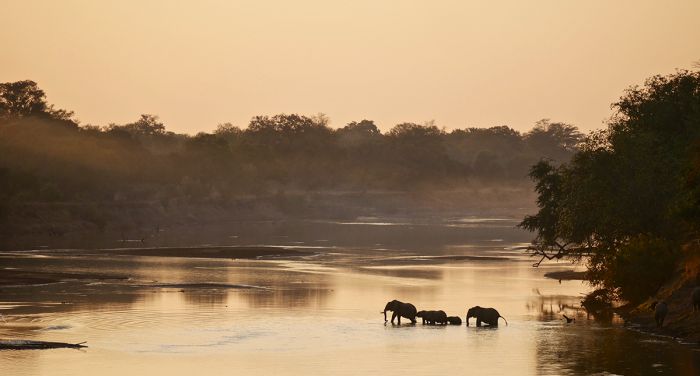
Elephants crossing the Luangwa River
Owing to the escarpment covering around one-quarter of North Luangwa, its habitats are more diverse than South Luangwa and birders in particular will find the park quite interesting.
Another aspect of North Luangwa is that it is 'zoned'. The southern portion, covering roughy 40% of the park, is restricted and may only be explored by guests staying at one of the small bush camps located along the Mwaleshi River. No self-drive safaris are permitted in this 'Wilderness Zone'. The remainder of the park is the 'North Zone' and is open to guests at safari camps and self-drivers. Overland trips and self-drivers enter the park via Mano Gate in the northwest.
The flora in the park consists of mature, evergreen woodlands on the upper reaches of the escarpment in the west, changing to miombo woodlands on the lower elevation hills down the escarpment, and finally to dense thickets of bush and sparse open areas on the valley floor.
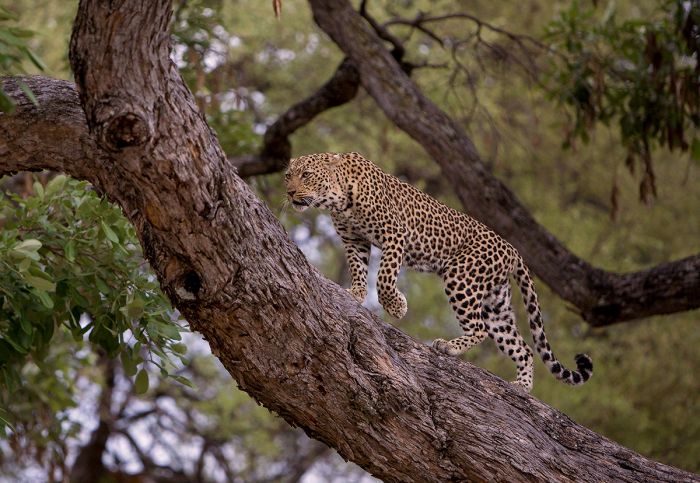
North Luangwa has excellent leopard habitat
Besides the always flowing (though sometimes very low) Luangwa River, North Luangwa's major feature is the Mwaleshi River. The Mwaleshi is a major tributary to the Luangwa and holds water all year, even during the dry season. There are three seasonal camps situated along the Mwaleshi and all three focus their activities on walking safaris.
The Luangwa Valley itself is a rift (called the Luangwa Rift), which forms an extension of the Great African Rift that begins in the north of Africa at the Red Sea. Some one million years ago, The Luangwa Valley was filled with water, forming a lake (called Lake Madumabisa) roughly the size of Lake Malawi. Changes in the rift eventually resulted in the draining of the lake and now the Luangwa River flows south out of the valley to join the Zambezi River, which flows east to the Indian Ocean.
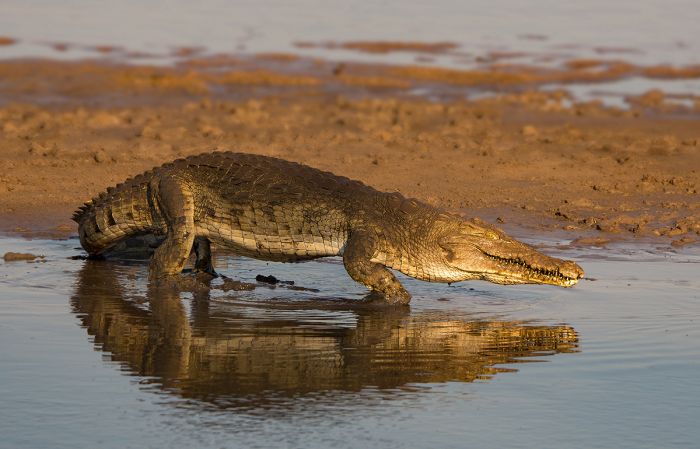
A nile crocodile along the Luangwa River
Wildlife
Generally speaking, the bush in North Luangwa is thicker than that in South Luangwa. Moreover, the road network in the North Park is much less developed, with most of the safari camps focusing on walking safaris rather than game drives. Consequently, visitors should expect the game viewing to be on a different level than in the South Park. This said, the experience in North Luangwa is incredibly rewarding, as walking safaris bring an entirely different feeling and respect for the wildlife that survive in this wild destination.
The wildlife found in North Luangwa is generally the same as that in South Luangwa, with a large variety of herbivores, including herds of buffalo. Puku and impala are common, as are Cookson's wildebeest (a Luangwa Valley endemic subspecies). Elephants are present, but tend to be more cautious than those in the South Park, as they see fewer people.
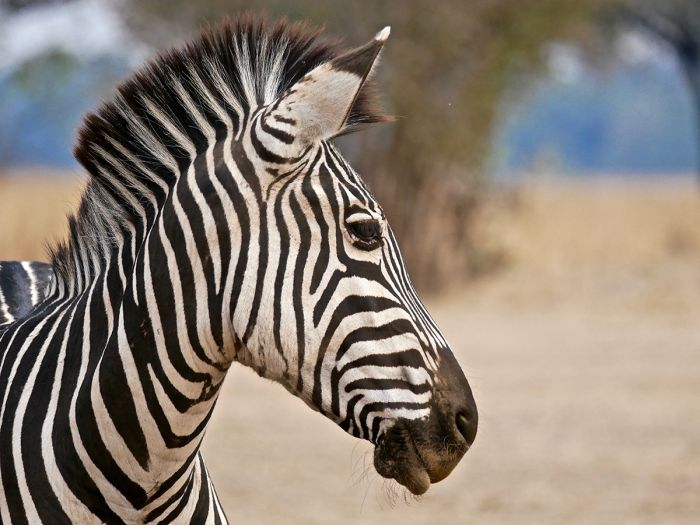
Crawshay's zebra is a locally endemic subspecies
Crawshay's zebra (a regionally endemic subspecies) are fairly common, as are eland, Lichtenstein's hartebeest, greater kudu, waterbuck, bushbuck, and oribi. Conspicuously absent in North Luangwa are giraffe, which are generally not found north of the Munyamadzi River due to the unsuitable habitat.
Lions are found in good numbers, as are spotted hyena and African wild dog. Leopard are common but elusive. Crocodiles and hippos are found in the Luangwa River.
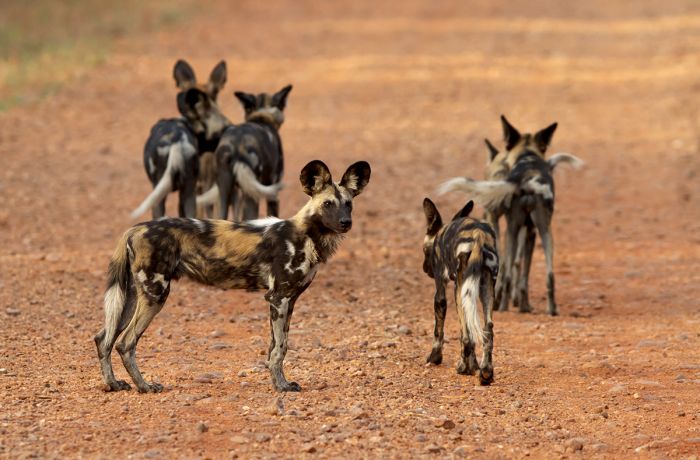
African wild dogs are commonly seen in Luangwa
North Luangwa also boasts Zambia's only wild population of black rhino. Luangwa's rhinos were hunted to extinction by poaching in the 1980s, but re-introduced by the Frankfurt Zoological Society's North Luangwa Conservation Programme. The rhinos are under constant guard and are kept in a protected area within the park.
Birding is superb, with even more diversity here than in the South Park, owing to the more varied habitats and in particular, the escarpment on the western side of the park. The escarpment is also home to sable antelope, bush pig, and blue monkey.
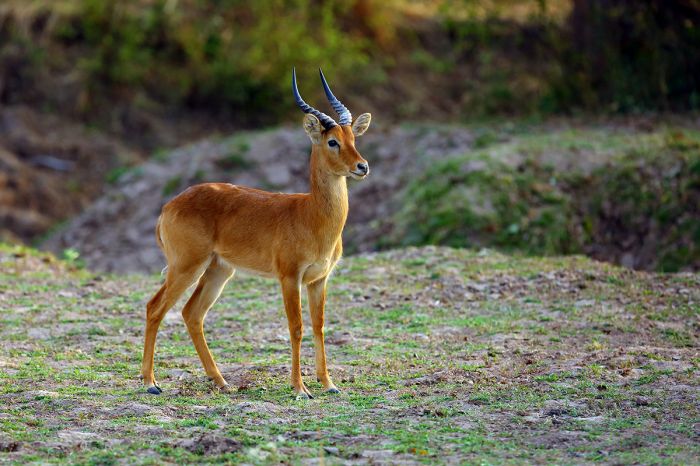
Puku are Luangwa's most abundant antelope
Walking Safaris
Norman Carr, the first warden of the Luangwa Valley's national parks, pioneered commercial walking safaris in the late 1960s for visitors to Luangwa. Today, walking safaris are a specialty in Luangwa and while the South Park offers mostly game drives with some operators focusing on walking, in the North Park, walking is the primary focus.
North Luangwa has only a few camps, all of which are seasonally closed for the rains and most offer no game drives and activities focus on walking. During the dry months, guests at these small bush camps enjoy walking safaris in the restricted 'wilderness zone', a truly special experience.
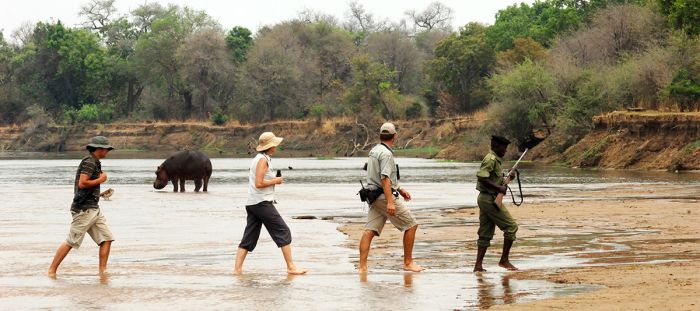
Walking at the Mwaleshi River (Copyright © Remote Africa)
Several operators in the South Park offer multi-day walking itineraries with stops at a different camp each night, the North Park's camps are separately owned and walking here generally entails half-day walking twice daily. The camps and walking in North Luangwa are based along the Mwaleshi River, which can be easily crossed on foot to follow the animals.
Read More...
Geography, History, Poaching, The Owens', Walking Safaris, Wildlife
Great Good Fair Poor
- Jan
- Feb
- Mar
- Apr
- May
- Jun
- Jul
- Aug
- Sep
- Oct
- Nov
- Dec
The Luangwa Valley experiences distinct wet and dry seasons, defined by summer rains and dry winters. Temperatures are warm even in winter and can be scorchingly hot during the late spring all summer. The few safari camps in North Luangwa are only open during the dry season (roughly June thru October) and close for the rains.
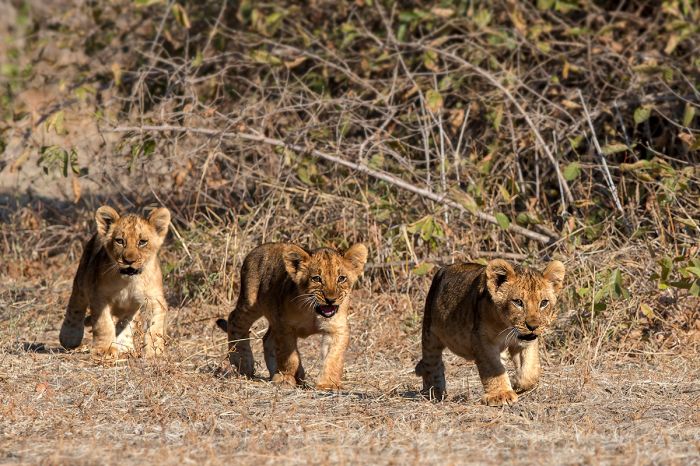
Lion cubs in the Luangwa Valley
Winter / Dry Season
The dry season in Luangwa spans May thru October and during this time, rainfall is reliably nonexistent. The safari camps in North Luangwa are only open during the winter months and this is the best time to visit. Game viewing is best at this time, with walking safaris focused around the Mwaleshi and Luangwa Rivers, as most animals stay close to these essential water sources.
Daytime temps in May/June/July average 80-82°F (27-28°C), while overnight temps fall to 50-52°F (10-11°C). Early mornings can be chilly, so dressing with a couple layers in wise. Game viewing is very good.
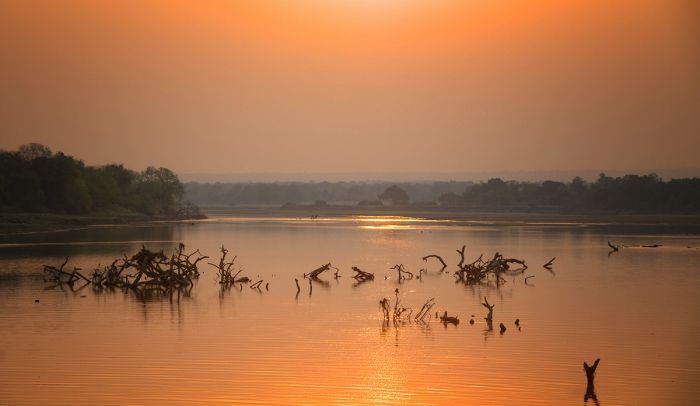
The Luangwa River at dusk
August & September are warm and dry, with exceptionally good for wildlife viewing around the rivers. Daytime temperatures average 90-92°F (32-33°C), with overnights dropping to 57-64°F (14-18°C).
October is the peak of the dry season and is typically scorchingly hot until the first rains arrive, which can occur late in the month or early in November. Daytime temps can reach 95-97°F (35-36°C) and it is warm even at night, with temps only dropping to 65-68°F (18-20°C). Game viewing is excellent.
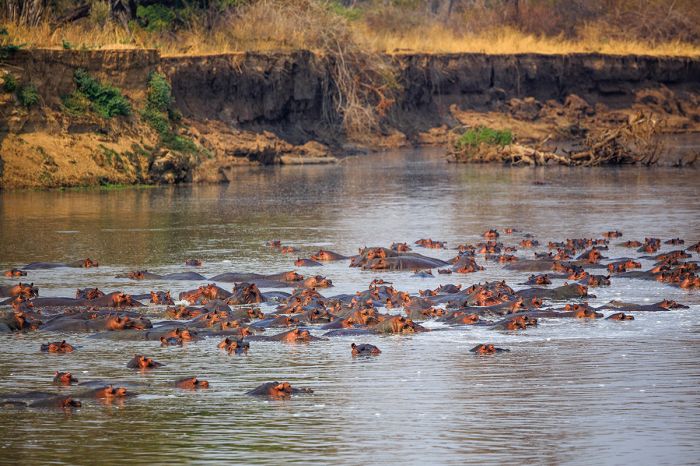
As water levels drop, hippos form huge pods in the Luangwa River
Summer / Rainy Season
The rainy season in Luangwa spans from November thru April. The safari camps in North Luangwa close for the rainy season. Although the park remains open to self-drive visitors, the park's remoteness and the difficulty of driving the roads in muddy conditions make it unwise to visit at this time.
November receives the first rains and the parched land comes alive in the first days after rains. Daytime temps remain hot, averaging 93-95°F (34-35°C).
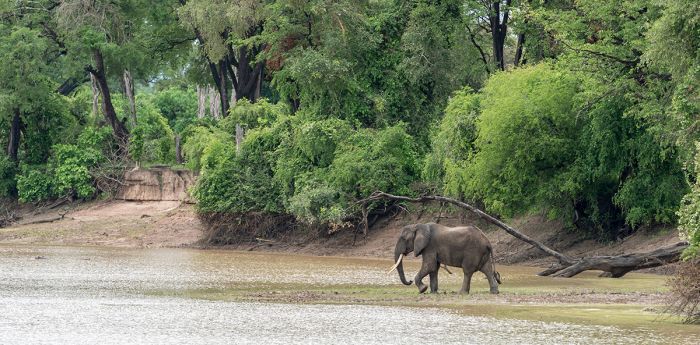
Al elephant approaches the Luangwa River
December thru March bring the heaviest rains and the rivers rise dramatically after heavy downpours. The roads can become very difficult to navigate or even impassible. Wildlife disperses away from the rivers, as food and ground water becomes widely available throughout the park. Day time temps average 85-89°F (29-32°C), with warm nighttime temps averaging 64-71°F (18-22°C).
April brings the end of the summer rains, with some showers still possible. The bush is lush and thick after months of rainfall. Daytime temps average 84-86°F (29-30°C) and overnight temps average 66-68°F (19-21°C).
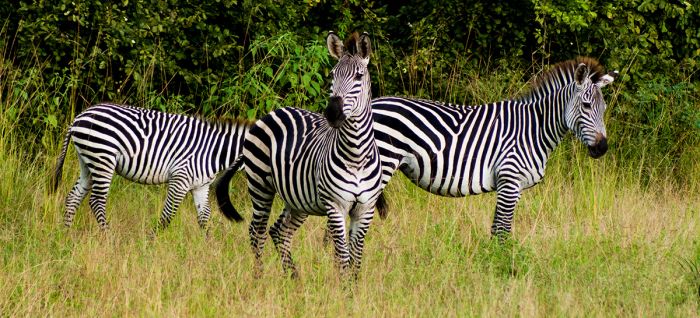
Crawshay's zebras at the end of the rainy season




